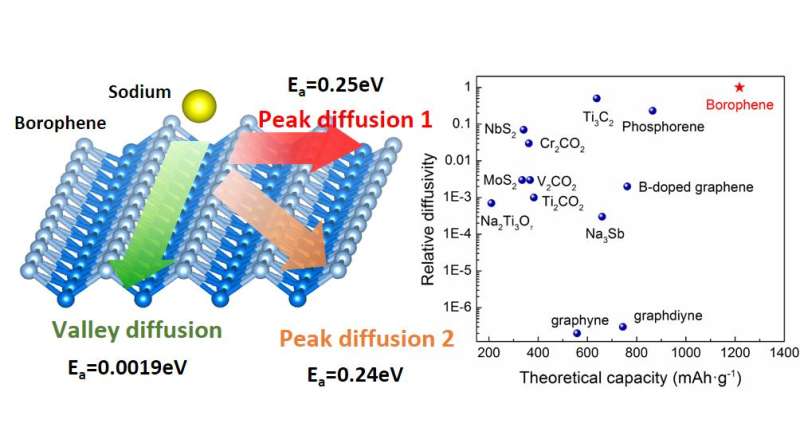Borophene could be an extraordinary sodium anode material for sodium-based batteries

Sodium-based batteries are a prospective alternative to lithium-based batteries due to the abundance and low price of sodium. However, finding a suitable anode material has been a longstanding hurdle to the commercialization of sodium-based batteries. As the size of the sodium atom is much larger than lithium, many anode materials widely used in lithium-based batteries show poor performance in sodium-based batteries, most of which suffer from low intercalation utility, slow kinetics and severe volume expansion.
Recently, a research team led by Prof. Tianshou Zhao at the Hong Kong University of Science and Technology comprehensively investigated the feasibility of using borophene, a newly synthesized 2D sheet of boron, as an anode material for sodium-based batteries via ab initio calculations. The calculation results show that during charge, the maximum Na/B ratio can reach 0.5 (Na0.5B), corresponding to a capacity of as high as 1218 mAh·g-1. The unique buckling structure of borophene leads to an anisotropic diffusion behavior. Along the valley direction of borophene, the diffusion energy barrier for sodium is as low as 0.0019 eV, corresponding to an ultrahigh sodium diffusivity, which is estimated to be more than a thousand times higher than that of conventional anode materials and one to seven magnitudes higher than other previously reported 2D materials.
This ultrahigh diffusivity is expected to revolutionize the rate capability of sodium-based batteries. During the charge and discharge process, the metallic feature and structural integrity of borophene is predicted to be well preserved, which ensures good electronic conductivity and stable cyclability. The calculated average open circuit voltages (OCV) is 0.53 V, which is an appropriate value for sodium-based batteries to maintain a high energy density while effectively suppressing the dendrite formation. Till now, compared with other reported sodium anode materials, borophene holds the highest sodium diffusivity.
More information: Le Shi et al, Ab initio prediction of borophene as an extraordinary anode material exhibiting ultrafast directional sodium diffusion for sodium-based batteries, Science Bulletin (2016). DOI: 10.1007/s11434-016-1118-7
Provided by Science China Press





















